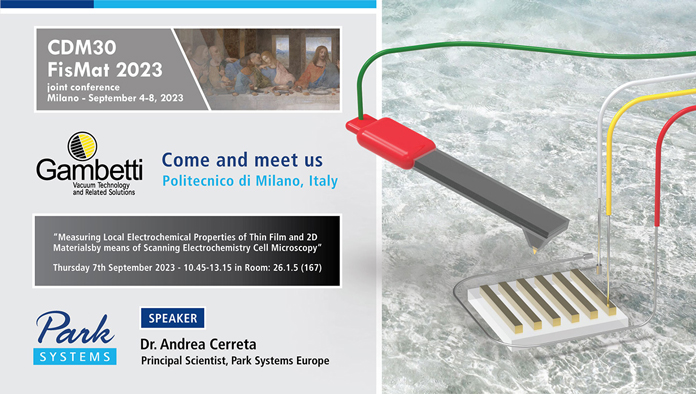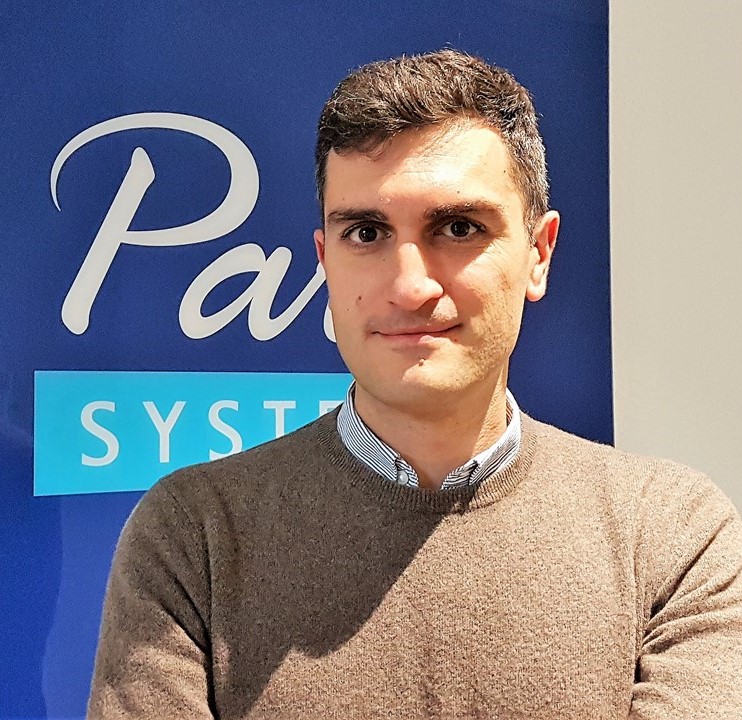
The FisMat 2023, the Italian national biennial conference on Condensed Matter Physics (including Optics, Photonics, Liquids, Soft Matter), will be a joint event with the biennial conference of the Condensed Matter Division of the European Physical Society (CMD30). The two events will take place at the Politechnic University of Milan and the University of Milan. In the past the FisMat has gathered almost 1000 scientists involved in condensed matter physics working in universities, research institutions and large-scale facilities.
- Date: 4-8 September 2023
- Location: Politechnic University of Milan, Building 26, Via Camillo Golgi, 20, 20133 Milano MI, Italy
Park Systems will be represented by our Italian distributor and partner Gambetti Kenologiy srl. Their team is looking forward to talking to you and to answering all your AFM related questions. Contact them today to attend a LIVE DEMO session on the Park NX10 AFM on September 6th.
_______________________________________________________________________________________________________________________

Join Dr. Andrea Cerreta, Principal Scientist, Park System Europe at the FisMat 2023 for his talk
- ⏩ TALK: “Measuring Local Electrochemical Properties of Thin Films and 2D Materials by means of Scanning Electrochemistry Cell Microscopy”
- ⏩ DATE: 7th September 2023 from 10.45-13.15 in Room: 26.1.5 (167)
ABSTRACT
Presenting Author: Dr. Andrea Cerreta¹, Co-Author: Dr. Alexander Klasen¹
¹ Park Systems Europe GmbH, Schildkrötstraße 15, 68199 Mannheim
Electrochemical applications can be found in almost every aspect of our modern economy: as an example, catalysts can be used to oxidize harmful nitrogen oxides in vehicle exhaust; fuel cells can convert hydrogen into clean energy; or metal oxides can facilitate the transition of bulk chemicals into target molecules.In particular, metal oxides are often used as heterogeneous catalysts, fixed on a solid surface with a large interface to either liquid or gaseous reactants or products [1]. The performance of such systems depends on several factors like surface area, chemical composition, or surface acidity/basicity [2,3]. Moreover, the electrochemical behavior of 2D materials has increasingly been investigated since these materials might pave the way to novel selective membranes or nanosensors [4-6]. Scanning probe microscopy-based techniques are well established to investigate surface parameters since the physical interaction with a nanometer-sized probe allows studying properties such as the topography, work function, or adhesion at high resolution [7,8].
In this presentation, we will go through the fundamentals as well as some recent examples from literature for Scanning Electrochemistry Cell Microscopy (SECCM), a technique first introduced by E. Daviddi, P. R. Unwin, et al. [9], which uses an electrolyte-filled pipette with an nm-sized aperture to probe electrochemical characteristics locally. We demonstrate how SECCM can be combined with conductive atomic force microscopy (C-AFM) to gain insight into the two-fold role of surface oxygen vacancies in TiO2 thin films. Whereas these surface defects create deep energy levels that trap electrons and subsequently hinder local conductance, they also act as catalytic centers. We demonstrate the effect of UV-ozone and Argon-plasma surface treatment on the local conductance and surface catalytic properties and investigate how illumination of the surface modulates the local catalytic activity. Finally, we provide examples of applications of SECCM for the study of the electrocatalytic response of 2D materials. Thus, we demonstrate that SECCM is a unique and easy-to-use tool to investigate the electrochemical properties of surfaces on a local scale.
References:
- [1] Ross, J. R. H. Heterogeneous catalysis: fundamentals and applications. (Elsevier, 2011).
- [2] Avelino, C. From microporous to mesoporous molecular sieve materials and their use in catalysis. Chem. Rev. 97, 2373–2420 (1997).
- [3] Xia, Y., Xiong, Y., Lim, B. & Skrabalak, S. E. Shape‐controlled synthesis of metal nanocrystals: simple chemistry meets complex physics? Angew. Chemie Int. Ed. 48, 60–103 (2009).
- [4] Brunet Cabré, M., Paiva, A. E., Velický, M., Colavita, P. E. & McKelvey, K. Electrochemical kinetics as a function of transition metal dichalcogenide thickness. Electrochim. Acta 393, (2021).
- [5] Cabré, M. B. et al. Isolation of pseudocapacitive surface processes at monolayer MXene fl akes reveals delocalized charging mechanism. 1–7 (2023) doi:10.1038/s41467-023-35950-1.
- [6] Cabré, M. B., Paiva, A. E., Velický, M., Colavita, P. E. & McKelvey, K. Electrochemical Detection of Isolated Nanoscale Defects in 2D Transition Metal Dichalcogenides. J. Phys. Chem. C 126, 11636–11641 (2022).
- [7] Eaton, P. & West, P. Atomic force microscopy. (Oxford university press, 2010).
- [8] Wiesendanger, R. Scanning probe microscopy and spectroscopy: methods and applications. (Cambridge university press, 1994).
- [9] Daviddi, E., Gonos, K. L., Colburn, A. W., Bentley, C. L. & Unwin, P. R. Scanning Electrochemical Cell Microscopy (SECCM) Chronopotentiometry: Development and Applications in Electroanalysis and Electrocatalysis. Anal. Chem. 91, 9229–9237 (2019).
_______________________________________________________________________________________________________________________





